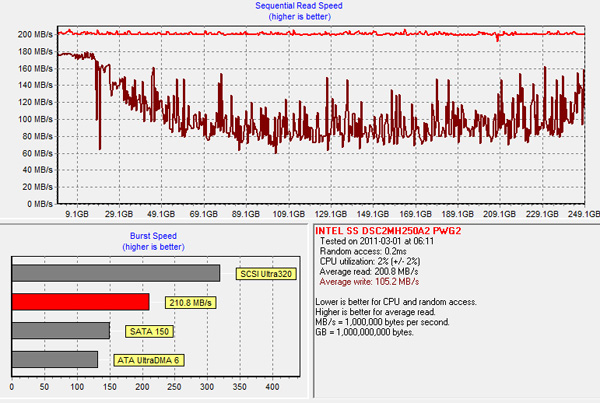The Intel SSD 510 Review
by Anand Lal Shimpi on March 2, 2011 1:23 AM EST- Posted in
- IT Computing
- Storage
- SSDs
- Intel
- Intel SSD 510
TRIM Performance
As expected, Intel's SSD 510 fully supports the ATA TRIM instruction. To gauge it's implementation I filled the 510 with data then ran a 4KB random write test (QD=32, 100% LBA space) for 20 minutes and measured performance using ATTO. I then TRIMed the entire drive by formatting it in Windows 7 and re-ran the ATTO test. The graphs below show clean, torture and and after TRIM performance.
First clean performance:

Next, after our torture session:

Once tortured the 510's performance drops as far down as 60MB/s for writes. A single TRIM pass restores performance to an almost-new state:

Worst case sequential performance isn't terrible, but worst case random write performance is pretty bad. Remember the ~50MB/s speeds from earlier? Those will drop down to ~5MB/s with an adequately fragmented drive. TRIM will recover performance but write amplification goes through the roof if you have a highly random workload. The 510 is suitable for desktop workloads, but anything more enterprise-like may be out of the question (at least not without significantly increasing the amount of spare area). I'm currently testing the 510 in a Mac to see how performance fares without TRIM over time.










128 Comments
View All Comments
lyeoh - Wednesday, March 2, 2011 - link
Oh yeah, thanks for the max latency figures. They're very useful.The G2's max of 900ms is quite a long time. Nearly a second! What are the max latencies for say a velociraptor in similar tests? I know the theoretical figures would be based on seek time + RPM but often theory is different from practice.
I find it interesting that the Crucial RealSSD C300 does worse than the Intel SSD 510 in the "Anand Storage Bench 2011- Heavy Workload" despite getting better numbers in the random and sequential tests. Any idea why this would be so? Poorer max latency?
jimhsu - Wednesday, March 2, 2011 - link
Poorer sequential performance I guess. The C300 (which I just got) is very fast, but the sequential perf of the 510 is simply better, which impacts a lot of the sequential portion of the workload test. Random performance in typical desktop models has reached somewhat of a plateau, particularly since most applications currently out there are optimized for the dog-slow random performance of consumer hard drives.Creepwood - Friday, March 4, 2011 - link
About reliability/compatibility: have you tested this drive in the new Sandy Bridge Macbook Pro? Any issues?davepermen - Monday, March 7, 2011 - link
Interestingly, one of THE main performance cases is when you need to quickly write lots of stuff, like in video editing. And there, all data is at least partially compressed, so i guess there the intel will be in a better place.RaistlinZ - Wednesday, March 2, 2011 - link
Intel is going to have to price this thing cheaper than the Vertex 3, or any other new Sandforce SSD for that matter. They can't use performance as a selling point. I'm sure the new SF controller will offer good stability. Unless you're an Intel fanboy I don't see any reason to get the 510 over the Vertex 3, unless they price it much lower.semo - Wednesday, March 2, 2011 - link
This is an Atom alright!I think the conclusion, although critical in places was overall mild. “It looks like we may have hit the upper limit of what we need from 4KB random write performance”… Yeah, in the consumer/budget space. But what consumer/budget computer user would buy a 250GB SSD. I’ve managed to convince a few of my clients to go with an “expensive upgrade” and in the end they’ve been extremely happy… In those cases I’ve only installed 64GB drives.
At the moment SSDs are NOT mainstream and it’s mostly the enthusiast and pro crowd that will be buying consumer grade SSDs. I’ll be using my SSD for VMs for testing and studying and I do a lot of heavy random IO operations.
For a drive as big and as expensive as the 250GB 510, I expect much better across-the-board performance.
TSnor - Wednesday, March 2, 2011 - link
Hi, the article states "~900ms write operation, the 510 keeps the worst case latency to below 400ms. The Vertex 3 by comparison has a max write latency of anywhere from 60ms - 350ms"microseconds are usually abbreviated us, where the u has a funny tail on it. (the u is greek for something)
ms usually means milliseconds. I usually type 'mics' when on the keyboard and reserve the funny u for when handwriting. example, a good SSD write takes less then 100 mics.
saying something is around 900 ms means it takes about a second.
epicsnackus - Wednesday, March 2, 2011 - link
The article is correct, the numbers are really in milliseconds. The microsecond numbers you're thinking of are 1) best case, and 2) usually readsChloiber - Wednesday, March 2, 2011 - link
"Write speed with fully incompressible data is easily a victory for the SF-2200 based OCZ Vertex 3."I think you meant fully compressible?
Anand Lal Shimpi - Wednesday, March 2, 2011 - link
Fixed! Thank you :)Take care,
Anand